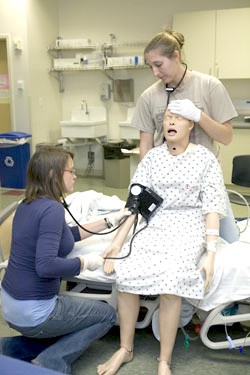Education Management Solutions brings new technology to GV’s Simulation Center

Courtesy Photo / gvsu.edu Grand Valley State University students practice on a medical mannequin in the Simulation and Learning center.
Jan 10, 2011
As students at Grand Valley State University take part in the Physician Assistant Studies program, they will now have the added benefit of new technology when class begins.
The new simulation software comes from Education Management Solutions and will be implemented in GVSU’s Simulation Center downtown.
The simulation center in the Cook-DeVos Center for Health Science has assessment labs, hospital simulations and other areas to help students familiarize themselves with a hospital environment.
EMS specializes in medical education. Medical schools across the country use the software it creates, which focuses on simulation, skill evaluation and audio-video technology.
Anurag Singh, president and CEO of EMS, said the simulation technology can be interpreted in different ways.
“Simulation could be using standardized stations, which are more like actors portraying political problems, or it could be using full body mannequins that have the capability of responding to certain interactions with the patients,” he said. “These mannequins can be controlled remotely by people who might be sitting behind a curtain and managing certain responses as students are working on those mannequins in an ER setting.”
Singh said the software EMS provides is important to universities like GVSU because of its ability to teach.
“I think it is very, very critical for the universities to be in a position to educate and train the learning population, which is primarily the students, and to be able to re-mediate and reinforce certain critical elements,” he said.
Dushy Edrisinghe, director of marketing at EMS, said the simulation software will help because of what it automates.
“EMS software helps to manage a university’s simulation program more efficiently by automating the operational workflow of a simulation lab or center,” she said. “It is the only software that automates paging announcements, which helps to move students, patient actors and evaluators through a number of simulated sessions on schedule.”
Other benefits of the new software include improved scheduling in regards to participants, rooms and equipment and improved inventory management.
Edrisinghe said simulation software allows students to perfect what they are doing.
“Simulation software allows learners to practice procedures they may encounter in a real health care setting several times until they perfect it in a safe environment,” she said. “It makes learners more confident and can lower risk to patients.”






















